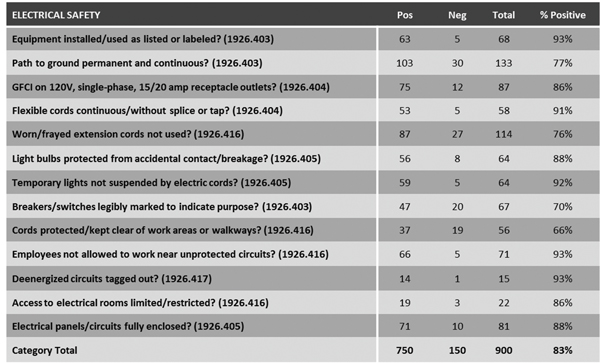
The Occupational Safety and Health Administration (OSHA) mandates that workers should never be required to work under conditions that are dangerous to their health or safety. They further require that an employer’s injury and illness prevention program must provide for “frequent and regular inspections of the jobsite” [reference 29 CFR 1926.20(b)(2)].
Contractors must ask themselves if they are properly completing OSHA-required frequent and regular inspections of their respective jobsites. In 10 years of doing safety audits for numerous contractors, I have observed that it is surprisingly uncommon for contractors to routinely schedule inspections, let alone document them. When asked why this is the case, many will say that their foremen or superintendents visually inspect the work site daily but that no one is documenting those inspections. A common saying among safety, health and environmental (SH&E) professionals is “if it’s not in writing, it’s not been done.”
What Gets in the Way?
To understand why more contractors do not document safety inspections, consider H.W. Heinrich’s classic Safety Pyramid. Heinrich theorizes that for every one serious accident, 29 minor injuries occur that are preceded by 300 incidents. If you expand this point a step further, a person may reasonably conclude that for every 300 incidents, thousands of unsafe acts or unsafe conditions occur in the workplace. This might explain why contractors do not spend much time doing traditional safety inspections. If the majority of accidents are caused by unsafe acts, why waste time documenting unsafe conditions? Why not focus on behaviors, the real source of worker injuries?
Reasons to Document
One reason is that eliminating unsafe conditions through frequent and regular safety audits can minimize the opportunities for employees to perform unsafe acts. For example, if an employee is trained on safe ladder use but falls from a ladder that slips out from under him because one of the non-skid pads is missing, is the root cause the unsafe act of choosing to use that particular ladder? Or could it be that the ladder was not inspected in the first place? If someone had inspected the ladder, it could have been taken out of service and the employee would never have had an opportunity to perform the unsafe act (i.e. use the damaged ladder).
Another reason to document safety inspections is that you might find that your jobsites are actually more compliant than you think. In my experience, many jobsites are 80 to 85 percent compliant, if not more, but many contractors don’t know this because they do not take time to document positive observations. In our ladder example, OSHA could have issued a serious citation for a defective ladder. However, demonstrating a normally high rate of compliance in regard to ladder inspections would have put the company in a better position to defend itself against OSHA and possibly get the citation reduced from serious to other-than-serious. At the very least, companies who document all aspects of safety inspections can illustrate good faith in their efforts to comply, and that alone has considerable merit.
Tracking Safety Compliance
When documenting safety inspections, management gains access to critical data for analyzing and trending safety compliance. New technology makes this easier than ever. Several safety apps are available on the market that allow one to quickly and easily upload hundreds, if not thousands, of safety observations onto a database for trending and analysis. By focusing their efforts on areas where they are most likely to see noncompliance, companies can significantly reduce the odds of receiving an OSHA citation for something that could easily have been prevented.
Furthermore, tracking safety observations provides solid statistical data to share with job crews to help drive safety improvement. The data in Table 1, for example, shows that electrical safety compliance needs improvement, as it has an overall percent positive score of just 83 percent. With something as critical as electrical safety, compliance must be much closer to 100 percent.
 Table 1
Table 1Tracking safety observations also provides the metrics to establish safety goals. One might set a goal, for example, of achieving at least 90 percent in each inspection category, including concrete/masonry, cranes/rigging, fire safety, ladders/stairs, safety training, etc. If a company’s goal is to achieve a score of 90 percent or better in all inspection categories, they may need improved safety training and/or management oversight to address deficiencies in certain areas.
One last point to consider is that data obtained through safety inspections can be used as part of a supervisor’s annual safety performance review, or it can be used to distribute safety bonuses. Consider the foremen safety scores below:
Foreman A – 87%
Foreman B – 92%
Foreman C – 79%
Using these numbers as an example, a contractor would distribute the maximum safety bonus allowed to Foreman B, who achieved a safety score of 90 percent or better throughout the year. Less money would be distributed to Foreman A, and even less or no money would go to Foreman C, who scored less than 80 percent.
In summary, contractors can gain numerous benefits from documenting jobsite inspections, such as:
- Minimize unsafe conditions, reducing the opportunity for workers to perform unsafe acts.
- Build a strong OSHA defense when positive observations are documented.
- Improve compliance and reduce the chance of receiving an OSHA citation.
- Drive continuous safety improvement when data is analyzed and trended.
- Use solid metrics to develop safety goals and improve supervisor performance.
- Conduct objective safety performance reviews to distribute safety bonuses equitably.
With OSHA enforcement activity at an all-time high and the cost of insurance increasing almost daily, choosing to not only document safety inspections but also track and trend them is an important step for any contractor.
